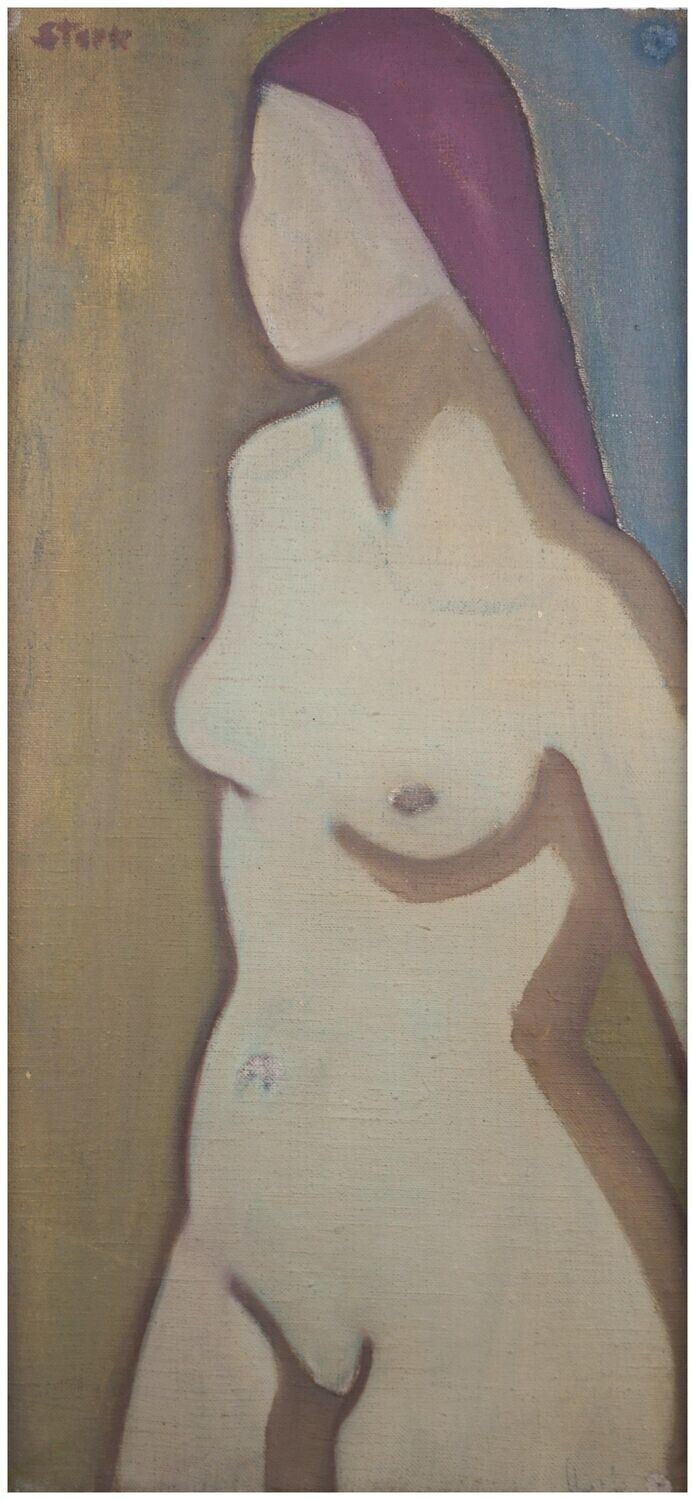Stark, Gustl (1917-2009), Kleiner Akt, 1946
Gustl Stark(1917 Mainz - 2009 ebd.), Kleiner Akt , 1946. Öl auf Leinwand, maroufliert, 54 x 25 cm (Darstellung), 30 x 60 cm (Rahmen), oben links mit „Stark“, verso zweifach mit „Gustav Stark“ signiert, als „Kleiner Akt“ handbezeichnet und auf „1946“ handdatiert. Mit Aufkleber der Ausstellung des Bonner Bundeshauses aus dem Jahre 1956.
- Beriebene Stelle im unteren Drittel des Körpers, auf derselben Höhe eine Retusche im ockerfarbenen Hintergrund. Im provisorischen Rahmen.
Exposé als
PDF
- abstrakte Figürlichkeit -
Im Krieg erlitt Gustl Stark einen Schicksalsschlag, der für einen Künstler besonders schwerwiegend ist: Er verlor seinen rechten Arm. Dennoch widmete er sich auch weiterhin ganz und gar der Kunst und das 1946, unmittelbar nach dem Ende der nationalsozialistischen Schreckensherrschaft geschaffene Gemälde zeugt vom Aufbruch in eine neue Zeit. Zugleich ist das Werk ein rares Beispiel für das frühe figürliche Oeuvre des Künstlers, da sich Stark bereits ab 1950 ganz der abstrakten Malerei zuwandte. Und auch dieses Bild ist keineswegs rein figürlich, vielmehr veranschaulicht es bereits Starks Hinwendung zur Abstraktion.
Wir sehen einen weiblichen Akt, der jedoch gesichtslos bleibt. Dies mag symbolisch gelesen und auf die unmittelbar vergangene Epoche bezogen werden, die angesichts der Schrecken verstummen und erblinden lässt – förmlich gesichtslos macht. In diesem Sinne ist die Figur so positioniert, dass sie ‚zurückblickt‘. Aber sie blickt eben nicht. Mag dieser Bedeutungsgehalt auch mitschwingen, wodurch das Gemälde zu einem wichtigen Werk der unmittelbaren Nachkriegszeit wird, geht es Gustl Stark hier doch primär um etwas anderes, nämlich um die Kunst selbst. Das Fehlen des Gesichts führt dazu, dass der Körper zu etwas Flächenmäßigem wird. Aufgrund der Ent-Individualisierung sehen wir keine konkrete Person in ihren individuellen Zügen, sondern eine Körperfläche. Und tatsächlich ist der Körper durch eine äußerst flächenmäßige Gestaltung aufgebaut. Selbst die Konturlinien, die die Körperlichkeit formieren, weisen einen eher flächenmäßigen als linearen Charakter auf, insbesondere dort, wo sie in beinahe gleichfarbige Schattenzonen übergehen. Und die Flächen sind nicht in sich modelliert. Das Inkarnat weist keinerlei plastische Abstufungen auf; die Körperlichkeit ist ganz ins Flächenmäßige zurückgenommen, was in demselben Maße auch für die Haare gilt. Zudem gibt es keinen einheitlichen Hintergrund, der die Figur vor sich erscheinen lassen würde, vielmehr ist der Bereich neben den Haaren bläulich gehalten, so dass eine Abfolge an erdtonalen Farbflächen entsteht, wodurch die Figur abermals in die Fläche zurückgebunden ist.
Nicht zuletzt wird die Flächenmäßigkeit auch durch die Maltechnik forciert. Gustl Stark malt direkt, a la prima , auf die grobe Leinwand, wodurch die Struktur des Bildträgers im Bild sichtbar bleibt und stellenweise – etwa um die Haare herum – die Leinwand selbst zu sehen ist. Dieses strukturelle all-over verleiht dem Bild per se etwas Flächenmäßiges.
Gustl Stark bedient sich mithin gerade jenes Motivs, das für die Körperlichkeit der Kunst schlechthin einsteht – dem weiblichen Akt –, um die Räumlichkeit des traditionellen Bildes in eine für die moderne Kunst charakteristische Flächenmäßigkeit zu überführen. Und dennoch wird ein starker Eindruck von Körperlichkeit erzeugt, ohne dass diese jedoch durch eine malerische Modellierung des Körpers erzeugt worden wäre. Aus dem Oszillieren zwischen Flächigkeit und Körperlichkeit resultiert die intensive Spannung des wegweisenden Bildes.
Innerhalb von Gustl Starks Oeuvre liegt es in der Konsequenz der hier vor Augen stehenden Abstraktion in einem weiteren Schritt die Figürlichkeit gänzlich absteifen, was – auf dieses frühe Schlüsselwerk geschaut – aber auch einen Verlust bedeutet.
zum Künstler
Gustl Stark war der Sohn eines Holzschnitzers und besuchte nach einer Lehre als Dekorationsmaler von 1936-1937 die Staatsschule für Kunst und Handwerk in Mainz. Obwohl er im Krieg schwer verwundet worden war und seinen rechten Arm verloren hatte, studierte er von 1943-1944 an der Mal- und Zeichenschule Würzburg und anschließend, von 1944-1948, an der Akademie der bildenden Künste in Nürnberg.
Beim staatlich ausgelobten Kunstwettbewerb in Bad Ischl gewann er ein Staatsstipendium. Es folgten zahlreiche Studienreisen nach Sylt, Paris, in die Schweiz, nach Österreich, Italien Holland und Belgien.
Gustl Stark war in Mainz tätig und dort der erste Künstler, der sich der abstrakten Malerei widmete. Schnell fand sein Werk auch internationale Anerkennung, so beschickte er unter anderem den Salon Réaliés Nouvelles in Paris.
Von 1963-1970 lehrte er am Staatlichen Hochschulinstitut für Kunst- und Werkerziehung in Mainz und hatte von 1970-1975 einen Lehrauftrag an der Johannes-Gutenberg-Universität inne. Eine besondere Bekanntheit erlangte Gustl Stark durche seinen farbigen Prägedruck, für den er eine eigene Technik erfunden hatte.
Für sein Schaffen wurde Gustl Stark mit zahlreichen Auszeichnungen geehrt. Unter anderem erhielt er 1962 den Kunstpreis für Malerei der Stadt Mainz, 1984 den Staatspreis des Landes Rheinland-Pfalz und 1987 die Gutenberg-Büste der Stadt Mainz.
Auswahlbibliographie
Hans Vollmer (Hrsg.): Allgemeines Lexikon der bildenden Künstler des XX. Jahrhunderts, Vierter Band, Leipzig 1958, S. 344.
Hans H. Hofstätter: Das malerische Werk Gustl Starks (= Kleine Schriften der Gesellschaft für bildende Kunst Mainz), Mainz 1962.
Wolfgang Venzmer: Zu Gustl Starks Prägetiefdrucken, Mainz 1982.
Gustl Stark: Prägetiefdrucke. Werkverzeichnis 1966-1990, Mainz 2003.

